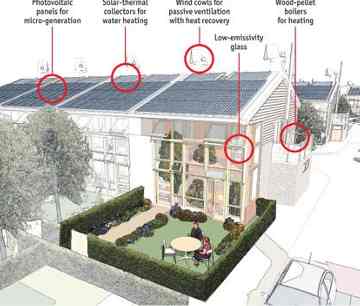 These days, with so many builders touting themselves as green, the whole idea of a green home can seem like a marketing ploy. Instead of stepping into someone else’s business plan, your home can be your own financial survival tool – that is what you can learn from looking at the off-grid way of life.
These days, with so many builders touting themselves as green, the whole idea of a green home can seem like a marketing ploy. Instead of stepping into someone else’s business plan, your home can be your own financial survival tool – that is what you can learn from looking at the off-grid way of life.
When a builder markets his homes as environmentally friendly because they feature water-saving toilets and high-efficiency gas furnaces, that’s a problem: You’d be hard-pressed to find a new home without these features. But here’s the thing: the relative improvements in resource consumption compared to the wasteful old ways are still way out of whack with the way you live if you are harvesting your own power and water, off the grid. You can live a comfortable off-grid life on 25% of the water and electricity that people regard as normal. But LEED standards are more like 50% or more – ie half what is “normal” but double what off-gridders would consume.
Some genuinely green homes bear labels such as Energy Star, LEED or R-2000. These are meaningful designations, but most of them are still energy intensive and water hungry compared to the amount you consume when you are generating your own power, and harvesting your own rainwater – not to mention disposing of your own waste.
A greener home sometimes means spending more money at the outset, or sacrificing square foot-age or high-end finishes. As good as our intentions are, it’s a trade many of us are reluctant to make. Availability can be another obstacle. We may have heard about a wonderful green builder, but if they don’t have a development in our preferred location, chances are we’ll pick someone who does.
And then there’s the size of home. Why do we in the West over-house ourselves so? We want big homes with space to spread out – but why not outside space, and why is it so hard to learn the listen that the bigger the house, the more it costs to heat and cool and maintain and of course build in the first place.
That is why small and tiny homes are becoming more widely accepted. Powered by solar panels and propane gas, a 400-square-foot home can be designed to eliminate the need for an electric utility connection. It can also offer the option of using a “gray water” filtering system and toilets that don’t need to be linked to a septic tank or sewer.
A portable “off-the-grid” house on display in Modesto, CA through Feb. 26 has “everything self-contained,” said Steven Lefler of Modular Lifestyles Inc., the company promoting the home as an affordable and environmentally friendly alternative to traditional housing.
“The cost of building a home on empty land is astronomical because of what it takes to connect to utilities,” Lefler said.
That doesn’t mean this home is a bargain. It’s priced at $69,500 — which works out to $174 per square foot — not counting the cost of land, site preparation or building permits.
By comparison, the median sales price for existing Stanislaus County homes, including the lots they’re built on, is about $80 per square foot, according to DataQuick, a real estate research firm.
“This home works in places that have high costs,” Lefler said about his so-called green alternative.
The Olive Lane Estates mobile home park hopes a larger version of the home will attract new tenants to its Claus Road community.
“We’re set to buy five solar homes, and we’ll probably rent them,” said Michael Ramsey, Olive Lane’s regional manager. The park has five empty spaces, so Ramsey said it is going to install two-bedroom, one-bath homes from Modular Lifestyles in those spots. The first of them is expected to arrive this month.
Lefler said those 784-square-foot homes sell for $60,000. He said they do not have as many features as the smaller home now on display.
Because the two-bedroom homes will not have electricity costs, Ramsey said he expects to rent them for $900 per month.
The average rental rate for traditional two-bedroom, one-bath apartments in Modesto is about $790 per month, but they have an average 847 square feet, according to RealFacts, which tracks rental property trends. Typical renters, however, must pay electric bills in addition to rent.
According to the Modesto Irrigation District, homes with 850 square feet or less pay an average electric bill of $115 per month.
The green homes from Modular Lifestyles are built in Arizona and trucked to California. Lefler said they are considered “green” because they have features such as cork flooring, recycled building materials, LED lighting and energy- efficient appliances.
The water heater, stove, furnace and back-up generator are powered by propane. Propane bills would have to be paid separately.
The 400-square-foot version of the home is available for public tours through Feb. 26 at Olive Lane Estates, 4628 Claus Road, Modesto, from 8 a.m. to 5 p.m. weekdays and on weekends by appointment, (209) 551-4294.
